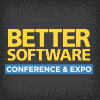Better Software Conference & EXPO 2008

PRESENTATIONS
|
Better Software Conference & EXPO 2008: Pragmatic Agility - Principles, Not Dogma
You've got questions. Andy Hunt has answers. What is agile software development all about? Why the sudden popularity of agile? Why is it fundamentally different from other approaches? Will it work for my organization and me? Join Andy, one of the seventeen original signatories of the Agile Manifesto and a founder of the Agile Alliance, for his pragmatic take on the answers to these and your other questions. Look at the foundations of agile software development and see what problems agility seeks to address. |
|
|
Better Software Conference 2008: Agile Software Testing Strategies
Test automation is like exercise. We know both are great ideas, but most of us don’t do enough of either. Although we know that creating a solid automated test suite is critical to any agile testing strategy, we are often just told to "Do it" without much support-money or people. Jared Richardson examines the infrastructure and tools needed for your automated testing to succeed and prosper. |

Jared Richardson, 6th Sense Analytics |
|
Beyond the Mission Statement: How Values Drive Behavior
Companies often invest a lot of time and money into defining their mission statement, expecting it to drive employee behavior toward the stated purpose. Unfortunately this is a myth. Instead it is values that drive behavior, and corporate values are often not part of the mission statement. We'll look at what other companies have posted as their mission statement and their values and how that has affected their business. We'll walk through a common example of how a mission statement without values can lead to project failures. |
|
|
Beyond User Stories: Managing Requirements by Business Need
The use of stories in agile projects is commonplace. However, teams in many organizations have discovered limitations in the user story's narrow view in complex projects. Attempts to coordinate related stories through "epics" and "themes" may help the details of managing the problem but generally leave the enterprise view unaddressed-particularly when multiple teams are working together. |
|
|
Continuous Integration: The Cornerstone of a Great Shop
Jared Richardson believes that of all the development practices being promoted today the best single practice is continuous integration. It's a simple concept-you run a software program that monitors your source code in an automated version control system. When anything changes, your code is automatically checked out, re-built, and all the automated tests are re-run. Continuous integration gives you an early warning if anything in the most recent changes broke the software. |

Jared Richardson, 6th Sense Analytics |
|
Deception and Estimation: How We Fool Ourselves
Cognitive scientists tell us that we are hardwired for deception. It seems we are overly optimistic, and, in fact, we wouldn't have survived without this trait. With this built-in bias as a starting point, it's almost impossible for us to estimate accurately. That doesn't mean all is lost. We must simply accept that our estimates are best guesses and continually re-evaluate as we go, which is, of course, the agile approach to managing change. |

Linda Rising, Independent Consultant |
|
Decision Making Under Extreme Pressure: Lessons Learned from Pilots in Crisis
Controlled Flight Into Terrain is an interesting book containing case studies of poor decisions made by pilots under extreme pressure. CFIT is an accident in which an otherwise serviceable aircraft, under the control of the crew, is flown (unintentionally) into terrain, obstacles, or water, with no prior awareness on the part of the crew of the impending collision. |

Lee Copeland, Software Quality Engineering |
|
Early Defect Detection for Software Analysis and Design
For large software development projects, the most important decisions-and the most expensive mistakes-are made at the beginning of the project. At the same time, the initial quality assurance activity is minimal but grows as development moves forward. This results in costly rework (often hidden) in the later stages of the project. Vladimir Pavlov explains how to reduce delays between bug insertions and bug fixes by allocating quality activities over the entire project in proportion to the importance of potential errors. |
|
|
Eight Steps to a Virtualized Test Environment
Virtualized software test environments deliver quantifiable benefits-lower lab costs, faster test cycles, and lower IT support overhead. New capabilities in virtualization and virtual test lab solutions are being brought to market by vendors such as VMWare, Surgient, VM Logix, and illumita. These tools promise compelling productivity improvements: richer test scope, tighter lab integration with test tools and processes, and on-demand test infrastructure. |
|
|
Fifteen Tips for Speeding up Your Project
Faster is better for software projects-if and only if all the right elements are in place and ready to go. Sometimes your organization is in a sweet spot-that period of time when your project should start immediately. Other times, it's better to wait. Join Johanna Rothman to discover how to decide whether your project is ready to go, including how to help your managers define the project portfolio to see where your project fits in and how it supports your organization's goals. |

Johanna Rothman, Rothman Consulting Group, Inc. |


